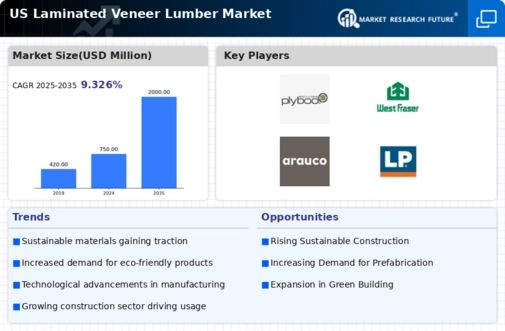Increased Construction Activities
The laminated veneer-lumber market is significantly influenced by the uptick in construction activities across the United States. With urbanization and population growth, there is a heightened need for residential and commercial buildings. In 2025, the construction sector is expected to witness a growth rate of around 6%, which directly impacts the demand for laminated veneer-lumber. This material is favored for its strength and versatility, making it suitable for various applications, including beams, columns, and flooring. The laminated veneer-lumber market stands to benefit from this trend, as builders increasingly opt for engineered wood products that offer both performance and sustainability. As construction projects proliferate, the laminated veneer-lumber market is likely to see a corresponding rise in demand, reinforcing its position in the building materials sector.
Rising Demand for Eco-Friendly Materials
The laminated veneer-lumber market is experiencing a notable increase in demand for eco-friendly materials. As consumers and industries alike become more environmentally conscious, the preference for sustainable building materials has surged. This shift is reflected in the construction sector, where the use of laminated veneer-lumber is seen as a viable alternative to traditional lumber. In 2025, the market is projected to grow by approximately 8% annually, driven by the need for sustainable solutions. The laminated veneer-lumber market is well-positioned to capitalize on this trend, as it offers products that are not only sustainable but also provide structural integrity and aesthetic appeal. This growing demand is likely to encourage manufacturers to innovate and expand their product lines, further enhancing the market's growth potential.
Growing Awareness of Wood-Based Solutions
The laminated veneer-lumber market is witnessing a rise in awareness regarding the benefits of wood-based solutions in construction. As architects and builders seek materials that offer both performance and environmental benefits, laminated veneer-lumber is gaining traction. In 2025, the market is projected to expand by 6%, driven by this growing recognition of wood's advantages, such as carbon sequestration and energy efficiency. The laminated veneer-lumber market is likely to capitalize on this trend by promoting the unique properties of its products, which combine strength with sustainability. This increased awareness may lead to a broader acceptance of laminated veneer-lumber in various construction applications, enhancing its market presence.
Technological Innovations in Manufacturing
Technological advancements in manufacturing processes are playing a crucial role in shaping the laminated veneer-lumber market. Innovations such as improved adhesive formulations and automated production techniques enhance the quality and efficiency of laminated veneer-lumber products. In 2025, the market is expected to grow by 7%, driven by these technological improvements that allow for greater customization and reduced production costs. The laminated veneer-lumber market is likely to see increased competition as manufacturers adopt these technologies to differentiate their offerings. Enhanced production capabilities not only improve product performance but also expand the range of applications for laminated veneer-lumber, making it an attractive choice for builders and architects alike.
Regulatory Support for Sustainable Practices
The laminated veneer-lumber market is benefiting from regulatory support aimed at promoting sustainable building practices. Government initiatives and policies that encourage the use of renewable materials are fostering a favorable environment for the laminated veneer-lumber market. In 2025, various states are expected to implement stricter building codes that favor engineered wood products, which could lead to a market growth of approximately 5%. This regulatory landscape is likely to incentivize builders to choose laminated veneer-lumber over traditional materials, aligning with sustainability goals. As regulations evolve, the laminated veneer-lumber market may experience increased adoption, further solidifying its role in the construction industry.















Leave a Comment